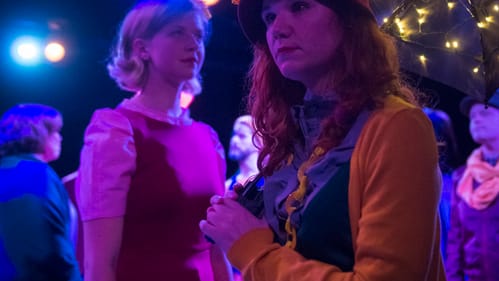Stay in the Loop
BSR publishes on a weekly schedule, with an email newsletter every Wednesday and Thursday morning. There’s no paywall, and subscribing is always free.
Art isn't easy
City Theater Company presents 'Sunday in the Park with George'

A successful production of Stephen Sondheim and James Lapine’s Sunday in the Park with George need only heed the advice of its creators. The 1984 musical opens with artist Georges Seurat explaining how to “bring order to the whole.” You do so “through design, composition, balance, light, and harmony.” Few of those elements are on display in City Theater Company’s (CTC's) muddled staging, directed by company cofounders Michael Gray and Tom Shade.
With Sunday, Sondheim and Lapine crafted one of the great artist’s statements of all time. The musical wrestles with the struggle to create meaningful work, the crippling self-doubt that often accompanies genius, and the artist’s painful inability to balance his professional and personal lives. Despite Sondheim’s intricate melodies and notoriously tongue-twisting text, the musical makes simple points, and benefits from a straightforward approach.
Some muss and fuss
Gray and Shade favor a fussier interpretation. Their largely modern-dress production (costumes by Kerry Kristine McElrone and Lauren Elizabeth Peters) takes the frame of a rehearsal, with the opening number slowly transitioning from a table reading into a fully staged tableau. We see George (Brendan Sheehan) fussing with light fixtures and stationing himself in several locations throughout the auditorium, searching for an ideal perspective. It becomes clear he’s not only the painter in this formulation — he’s also the director.
The narrative device occasionally works. After Dot (Jenna Kuerzi), George’s model and muse, complains she’s always stuck posing in the hot sun, George signals and suddenly she’s awash in blinding light (designed by Vicki Neal and Richard A. Kendrick). You can practically feel the heat radiating from her. And I appreciated the trenchant humor of George performing most of “The Dog Song” from the audience, with the stage occupied solely by the stuffed French bulldog he’s sketching.
But other choices remain inexplicable. Why do Gray and Shade have three choristers shadow Dot during “Color and Light,” mimicking her every move? The song represents a moment of introspection for a character who may seem outwardly shallow. Crowding the stage with unnecessary bodies robs Dot’s private reflections of their much-needed subtlety.
And why, in the second act — when the action segues from 19th-century Paris to the 1980s New York art scene — do many of those same choristers turn into aggressive museum docents, forcibly shoving Seurat prints into the hands of audience members?

When the perplexed patrons don’t pass the pictures fast enough, the performers turn hostile, sometimes physically tearing them from our hands. Should this represent our ability to appreciate great art? All it really does is distract from the actual scene being played simultaneously, which has a lot more to say than this glib insertion.
A few point of light
Stirring performances from the central couple compensate for some directorial missteps. Sheehan’s warmly expressive bari-tenor voice caresses Sondheim’s melodic lines, but he never rests on his vocal laurels. He conveys both the tortured genius of Seurat and the pressure of expectation that nearly cripples his Act Two alter ego, a visual artist who carries the weight of legacy on his shoulders.
Kuerzi similarly taps into the many facets of Dot’s personality. She’s appropriately funny and flirty in “Everybody Loves Louis,” a paean to settling for life’s simple pleasures. A moment later, she delivers a devastating “We Do Not Belong Together.” Rarely have I heard Dot’s burgeoning cry of self-actualization — “No one is you and no one can be / But no one is me, George / No one is me!” — ring out with such authority. She brings humor and pathos to the second-act role of Marie, Seurat and Dot’s illegitimate daughter.
The supporting company never uniformly rises to the level of Sheehan or Kuerzi, although some standouts emerge. I found Mary Catherine Kelley particularly moving as Seurat’s ailing mother, who implores her son to capture the important moments of life before they pass him by. Tonya Baynes makes an imperious Yvonne in Act One and a nurturing Elaine in Act Two, and Jim Burns is appropriately salty as the Boatman, who rails against the “silly little simpering shopgirls” and “condescending artists.”
A five-piece orchestra renders Sondheim’s score beautifully, with particularly lovely contributions from Steven Zimmerman (saxophone, clarinet, and flute) and Linda Heckert (French horn). But despite the high musical quality, coordination problems between performers and band persist throughout the evening.
Dot returns for the musical’s final scene, where she implores George — now her great-grandson — to “give us more to see.” Sage advice. But in CTC’s case, it’s probably better to learn that less is more.
What, When, Where
Sunday in the Park with George. By Stephen Sondheim and James Lapine, Michael Gray and Tom Shade codirected. City Theater Company. Through December 16, 2017 at Opera Delaware Studios, 4 S. Poplar Street, Wilmington, Delaware. (302) 220-8285 or city-theater.org.
Sign up for our newsletter
All of the week's new articles, all in one place. Sign up for the free weekly BSR newsletters, and don't miss a conversation.

 Cameron Kelsall
Cameron Kelsall